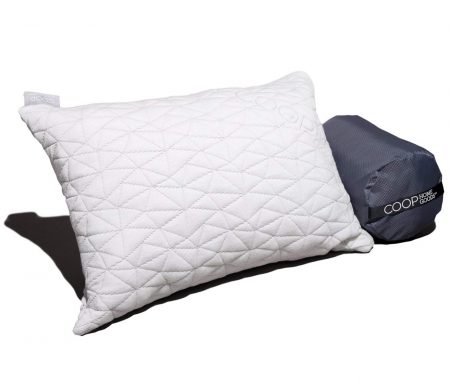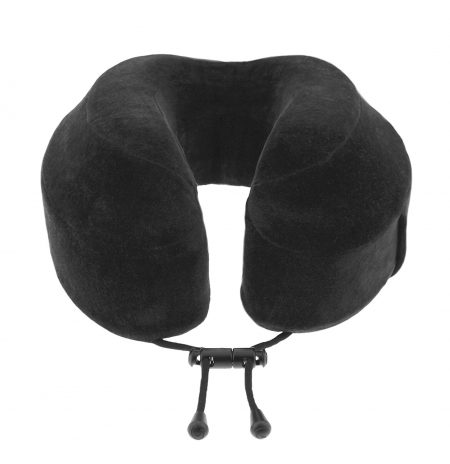Inflatable Travel Pillows
The majority of travel pillows sold today are U-shaped models designed to rest on the shoulders with both ends facing forward. For added neck support, some of these U-shaped pillows have raised backs with a gentle curve; this ergonomic-minded design can help prevent neck pain and pressure.
Some U-shaped pillows are long enough to be completely wrapped around the neck. This provides 360-degree support, allowing sleepers to crane their neck at the most comfortable angle.
In addition to U-shaped designs, some travel pillows mimic the rectangular shape of bedroom pillows. Other designs include thinner, fabric wraps with a foldable built-in neck brace for a flat resting surface; and long, slender models that can be embraced like body pillows.
Regardless of shape, travel pillows can generally be divided into two categories: inflatable and non-inflatable. First, let’s look at inflatable models. Common characteristics of inflatable designs include the following:
Travel pillows can generally be divided into two categories: inflatable and non-inflatable. First, let’s look at inflatable models. Common characteristics of inflatable designs include the following:
Inflation Method
Some inflatable travel pillows fill up the old-fashioned with: with human oxygen. They feature a tightly sealed air valve that allows users to blow into the pillow until they reach their desired loft. Some newer models feature inflation systems that do not require human oxygen. Instead, the user opens a valve and presses down on a button until the pillow is properly inflated. In either case, the loft is adjustable. However, it’s important to never overinflate a travel pillow; this can cause the pillow to burst at its seams, or otherwise damage its structural integrity.
One notable downside of inflatable pillows is that they will probably deflate to some extent after a few hours of use — especially at high altitudes. Sleepers may be most comfortable by slightly over-inflating before use in order to compensate for the lost air.
Material Composition
Most inflatable pillows feature a shell made from polyurethane-based material, such as polyvinyl, which can be slick and cold to the touch. To provide more resistance and a warmer feel, inflatable pillows often have a cover made of materials like velvet or velour.
These covers also create a more hygienic barrier between the sleeper’s face and the pillow shell, since they are removable and can be machine washed; polyurethane shells should never be laundered.
Compactness
While all travel pillows are fairly compact by definition, deflated travel pillows take up much less space than non-inflatable models (which cannot be reduced in size). This makes inflatable pillows more suitable for lengthier trips, since they take up less luggage space, as well as backpacking trips. Most inflatable pillows weigh 10 ounces or less.
Price-point
The average price-point for inflatable travel pillows is lower than that of non-inflating models. Expect to pay between $10 and $20 for a new inflatable pillow.
Non-Inflatable Travel Pillows
Next we’ll discuss non-inflating pillows. Common features of these models include the following:
No Adjustment
Unlike inflating travel pillows, non-inflating models cannot be adjusted in terms of loft due to their solid construction. If possible, sleepers should test out these pillows before purchasing to determine if they meet loft preferences and needs.
Material Composition
Most non-inflating travel pillows sold today are made from memory foam, also known as viscoelastic polyfoam. This material is designed to become softer when it comes into contact with body heat, and then recover its shape once it begins to cool down. Travel pillows are typically made from firmer memory foam that will provide continuous support to the head, neck, and spine; softer foam tends to sink, which can lead to neck pain.
Like inflating pillows, non-inflating pillows made from memory foam often come with removable, washable covers. Non-inflating designs made from other materials (such as polyester or fleece) may not feature a cover, but these materials are usually machine washable. These pillows are usually filled with beads or polyester puffballs, which tend to be less comfortable — and if the pillow develops a tear, these fill materials may escape and compromise the pillow’s overall loft.
Thickness
Since they are not adjustable, non-inflating pillows tend to have more loft than inflatable ones. The downside to this is that they tend to be bulkier are harder to fit into luggage than inflating models that can be deflated and reduced in size. The material of non-inflating pillows may be scrunched or molded to make more room, but these pillows may not be suitable for travelers who have limited space, such as backpackers and those taking extended trips. On the other hand, non-inflating pillows may be ideal for short trips or car camping.
Price-point
Non-inflating pillows tend to be the more expensive option — though most are still generally affordable. Shoppers should expect to pay between $10 and $40 for a new non-inflating travel pillow.
The table below compares inflating and non-inflating travel pillows in terms of design, composition, price, and other factors.
Important Considerations for Travel Pillow Shoppers
If you are in the market for a new travel pillow, here are a few factors to keep in mind when comparing different brands and models:
- How much does the pillow cost? The vast majority of travel pillows are available for sale at $40 or less, but inflatable pillows tend to cost less than non-inflating ones.
- What is the loft of the pillow? Inflating pillows can be adjusted to achieve proper loft for each sleeper, but even when inflated to capacity these pillows tend to be medium-loft. Non-inflating pillows cannot be adjusted, but they may be medium- or high-loft.
- How does the pillow inflate? Inflatable pillows may be inflated manually with human oxygen, or fill with air using built-in valves and buttons. Choosing between the two often comes down to personal preference — although placing one’s mouth on the air intake valve is considered somewhat unhygienic, particularly if more than one person uses the pillow.
- Does the non-inflating pillow consist of one or two pieces? Some non-inflating designs feature a memory foam shell and a washable cover, while others are one-piece designs made of washable material with bead or puffball fill. The majority of travelers seem to prefer the feel of memory foam compared to one-piece designs made of materials like polyester or fleece.
- Is the pillow or cover machine washable? The vast majority of travel pillows either have a removable, washable cover or are themselves machine washable. This is important for hygiene, as oils and bacteria can accumulate on the pillow’s sleeping surface.
- How much space does the pillow take up? Non-inflating pillows are fairly compact when they are deflated — but owners should make sure they will not come into contact with sharp objects inside their luggage. Non-inflating pillows can be bulkier and harder to fit into bags.
- What position do you prefer to sleep in? Those who sleep on their back usually find that U-shaped pillows offer the most comfort and support. However, side-sleepers who are not accustomed to leaning their heads back may find that differently shaped pillows are more comfortable and supportive.
- Does the pillow include a warranty? In rare cases, travel pillows come with product warranties that may last as long as two years, but most do not come with any sort of warranty. Some pillows that do not include a warranty may provide a money-back guarantee with proof of receipt instead.
Tips for Sleeping Well While Traveling
Getting great sleep during travel time can make a world of difference once you reach your destination. Of course, each type of travel comes with its own challenges. Airplanes are short on humidity, while buses and trains may have lots of disruptive stops. No matter the transportation method, these general tips for will help you sleep better while traveling.
- Come comfortable: Long gone are the days where you have to dress up for travel. Wear loose clothing that allows for healthy blood flow. Bringing along layers like a sweater or hat will help you stay warm if temperatures fluctuate.
- Drown out light: Buses, airplanes, and trains are full of light disruptions that may not match with your sleep cycle. Bring a quality sleeping mask that will ward off disturbing lights and allow you to sleep through the duration of the trip.
- Block noise: Airplane cabins can reach up to 105 decibels in the cabin, and long-term exposure to those noises aren’t great for your ears. You can prevent this problem by wearing noise-canceling headphones or earplugs.
- Stay hydrated: While it’s important for all travelers to stay hydrated, this is especially true for air travelers. Low humidity in a cabin predisposes you to dehydration. Drink water and limit alcoholic drinks to a minimum. Most airports make you dump out water at security, but you can work around this by bringing an empty water bottle and filling it up at the water fountain before you board.
- Pack healthy snacks: Avoiding high-sodium snacks will keep you hydrated. Instead, opt for foods that will help you sleep better. Snacks such as milk, cheese, nuts, cherries, and bananas are portable and ideal for the job. That’s because they have active ingredients like tryptophan, calcium, and magnesium that signal to your body it’s time to doze off.
- Position your body well: Try to keep your spine aligned as well as possible while you sleep and let your muscles relax. Make sure not to cross your legs for long periods of time as it may restrict blood flow and result in a “sleepy”, tingly sensation.
More Sleep Accessories for Travelers
In addition to a supportive pillow, the following accessories may come in handy for sleep-deprived travelers.
Headphones
Headphones are a noise-blocking sleeping staple for many travelers. Additionally, listening to music using headphones at a reasonable volume can help lower one’s heart rate and alleviate stress prior to falling asleep. Headphone styles that are currently sold include on-ear, over-ear, and in-ear (also known as earbud) designs. Standard models are available through most retailers for $30 or less, but shoppers may prefer to spend a little extra for sophisticated headphones that block outside noise more effectively; these models may cost up to $250.
For more information, please visit our Best Headphones for Sleeping guide.
Earplugs
Rather than listening to music, some sleepers prefer to block noise using a pair of earplugs. The majority of earplugs used today are made from compactible, flexible materials like foam, silicone, or wax. These materials offer a snug fit that conforms closely to the unique contours of their ear canal. Shoppers should take note of the Noise Reduction Rating, or NRR, when comparing earplug models; this may range from 20 to 34, and higher ratings are associated with more effective noise-blocking. However, it’s important to note that using earplugs has been linked to certain health problems, including earwax impaction, ear infections, and hearing loss.
To learn more, check out our Best Earplugs for Sleeping guide.
Sleep Masks
Sleep masks are essentially blindfolds that help people sleep in environments where they can’t control light (such as airplanes or other forms of public transportation). By simulating darkness, sleep masks can help facilitate the production of melatonin, a natural hormone that controls one’s natural sleep cycle. Sleep masks are usually made from fabrics such as cotton, silk, and/or polyester, and some also contain foam for extra cushioning. Most sleep masks are available for $20 or less.
Visit our Best Sleep Mask Reviews for more information.




